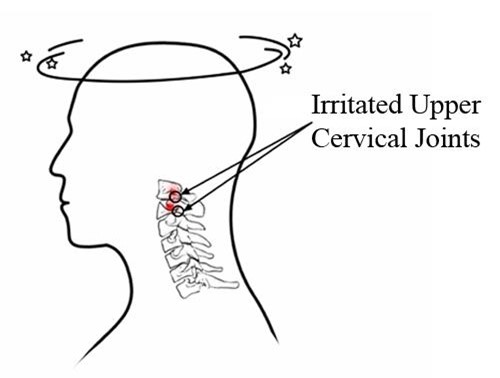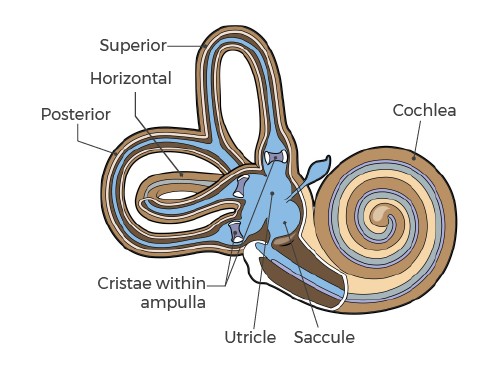There are two types of vertigo we manage in this office, benign paroxysmal positional vertigo and cervicogenic vertigo
Your brain processes three different inputs to establish your sense of balance: your inner ear, your eyes, and tiny pressure sensors that line the inside of the joints of your upper neck. Each of these systems relays information to your brain about the position of your head and body. Dizziness or “vertigo” arises when one or more of these balance systems malfunctions and can “confuse” your brain by sending incorrect information.
When you lean your head sideways, the pressure sensors on that side of your neck are triggered and relay information to your brain about the tilt of your head. When your inner ear and eyes agree with this information, all is well. If one of the joints in your neck becomes abnormally restricted, its pressure sensors are “falsely” stimulated. This sensory mismatch, called “cervicogenic vertigo”, confuses your brain into a temporary state of dizziness until it can sort things out. Cervicogenic vertigo can develop when the muscles of your neck are too tight or the joints become stuck in an abnormal position. Certain conditions, like joint swelling, disc bulges, muscle tightness, or arthritis can be triggers for cervicogenic vertigo. This condition commonly develops after “whiplash” injuries.
Cervicogenic vertigo causes a feeling of light-headedness, floating, unsteadiness, or general imbalance, but rarely, true “spinning.” Your symptoms likely come and go and are provoked by movement and eased by remaining still. Many patients report some neck discomfort or stiffness associated with their dizziness. You may notice a headache beginning near the base of your skull. Be sure to tell your provider if you have a “severe” or “different” headache. You should also inform your provider if you have a history of head injury, loss of consciousness, frequent unexplained falls, hearing loss, ringing in your ears, ear “fullness”, earache, fever, numbness or tingling in your face or arms, visual disturbances, difficulty speaking, difficulty swallowing, difficulty walking, or if you are taking a new medication.
Conservative chiropractic care, like the type provided in our office, is very effective at relieving cervicogenic vertigo. One of the world’s leading experts states: “in no field is manipulation more effective than in the treatment of vertigo.” Studies have shown a greater than 90% success rate for the chiropractic treatment of cervicogenic vertigo.

Your inner ear houses powerful balance sensors called semicircular canals. Each canal is a tube filled with fluid. When you move your head, the fluid bends tiny nerve-hairs that line the inside of each canal. This stimulation is sent to your brain, which compares the data to input from your eyes and upper spine to determine balance.
Benign paroxysmal positional vertigo (BPPV) upsets this mechanism and is the most common cause of dizziness. BPPV develops when unwanted debris or crystals move into one of the semicircular canals. This debris stimulates the tiny nerve-hairs and tricks your brain into thinking your head is in another position. You feel dizziness or vertigo because your brain is temporarily confused by contradictory signals from your ear, eyes, and neck. If you remain still, your brain is generally able to sort out the bad signal and reestablish balance…until you move your head again.
BPPV causes sudden episodes of dizziness or spinning that last 10-20 seconds following head position changes. Dizziness often increases when you arise or roll from side to side in bed, bend forward, or move your head to look up, down, or side to side. Nausea or vomiting may accompany severe episodes. Dizziness poses a significant risk to your safety, particularly if you have limited mobility or other balance disorders. Episodes of dizziness, while driving or walking (especially steps) can lead to falls. Some patients may require temporary in-home help to reduce the risk of falling.
Fortunately, your provider can perform repositioning maneuvers that shift your head into a position where the unwanted debris moves back out of the canal. The success of the procedure is very high (80-95%); however, multiple treatments may be required, and symptoms return in approximately 15% of patients each year.
Credit: Information on this page provided by ChiroUp.

My family have used chiropractic and physical therapy services here and every one of us have had excellent outcomes. I wouldn’t go anywhere else these folks are as good as it gets.
Very professional and in depth consultation. These people seem to genuinely care about people’s health and progress.
I really love it here! They are very friendly and I feel Dr. Wilson is giving me great treatment! I also don’t feel pressured into coming back too frequently. The adjustments are great! Great office!
Dr. Matthew squeezed me in on short notice and took very good care of me. He was very thorough and didn’t just adjust me and let me walk out. Amazing experience here and the receptionist is a sweetheart.
Dr. Matt has done wonders for me and I recommend him highly – I can’t say enough good things about him. Dr. Matt and staff are good people and will take great care of you.
Dr. Matt and the entire staff have been GREAT! I went in for some issues I was having with my neck and back and Dr. Matt also helped me with some other issues I was having with my calf and shoulders that have made a HUGE improvement in my overall health and comfort.
I highly recommend using Dr. Matt!
